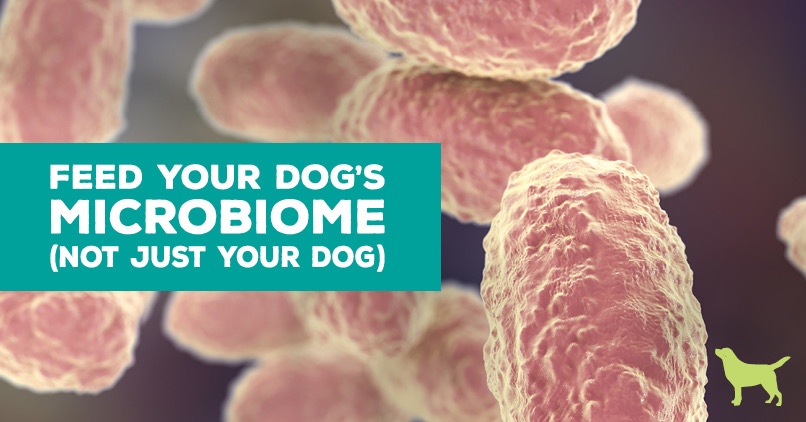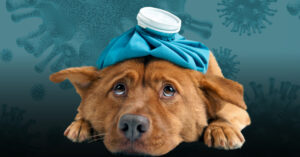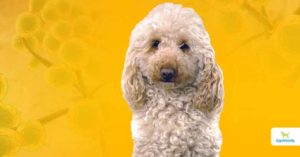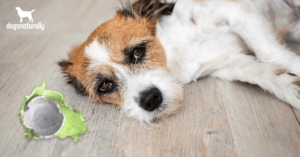If you own a dog, don’t think he’s your only pet. Your dog comes with trillions of little friends who manage his microbiome. And if you neglect to treat his friends as well as you treat your dog, his health will suffer.
His micro what?
Well, your dog is made up of trillions of little cells. These cells form your dog’s bones, organs, and skin. And their functions are controlled by your dog’s genes.
But there are other residents in your dog … tiny little microorganisms like bacteria, fungi, viruses. The bacteria in your dog outnumber his cells 10 to 1!
And the bacteria genes outnumber your dog’s genes by more than 100 times. These little communities of microbes are called the microbiome.
What Is The Microbiome?
Inside and outside your dog are complex colonies of bacteria and other microorganisms. They live in your dog’s ears, on his skin, in his mouth, and in his respiratory tract.
The vast majority of these bacteria (or microbes) live in your dog’s digestive system. These bacteria find other bacteria that can support and benefit them.
This relationship is how they grow to form colonies and survive.
And these little colonies support and benefit your dog as well.
In fact, the microbiome is so important to your dog’s health that it’s called the “forgotten organ”.
The microbiome helps your dog with a number of important functions. Let’s look at the five main ways the microbiome supports and protects your dog:
1. Protection Against Pathogens
The microbes in your dog’s microbiome can protect your dog from:
- Viruses like parvovirus or distemper
- Fungi like yeast
- Harmful bacteria like E. coli or salmonella and other pathogens and leptospirosis or Lyme
The friendly bacteria secrete chemicals that can kill off these harmful invaders.
When friendly bacteria outnumber the pathogenic bacteria they steal nutrients and space. This starves the pathogenic bacteria and leaves them nowhere to attach to in the gut.
2. Forms A Protective Barrier
The microbiome can form a protective barrier. This offers defense against drugs, toxins, allergens, and carcinogens (cancer-causing substances).
The little microbes can also attach to invaders. This prevents toxins from moving deeper into the body and removes them in the feces
3. Your Dog’s Microbiome Feeds Your Dog
The microbes in your dog’s microbiome aren’t parasites … they’re not like worms that steal nutrients from your dog, In fact, the opposite is true!
The friendly bacteria in your dog’s gut microbiome produce special proteins called enzymes. These help your dog digest and use his food. If those friendly bacteria aren’t around, your dog won’t get the nutrition he needs from his meals.
These bacteria transport nutrients across the intestinal wall and into your dog’s bloodstream. This provides energy support to his cells to maintain their health and build new ones.
The microbiome produces vitamins for your dog … especially thiamin and the B vitamins. In fact, vitamin B12, or cobalamin, is only made by bacteria in the digestive tract.
And B12 plays an important role in immune function. If your dog is vitamin deficient, the cause could be his gut and not his diet.
These microbes also produce short-chain fatty acids by fermenting fiber in your dog’s colon. These critical fats help to absorb important minerals, including calcium, magnesium, and iron.
4. Affects Your Dog’s Mood
Does your dog think with his stomach? That’s a good thing!
The gut-brain axis is his communication system between the microbiome and his brain. As crazy as it sounds, the little bugs that live in your dog talk with your dog’s brain through nerves and hormones.
The brain can signal the microbiome and demand more food or even control the immune system. Scientists have just begun to explore this connection but it’s clear that it does exist.
Research has found changes in the types of gut bacteria when animals are exposed to stress. Stresses such as premature maternal separation, social stress, and prolonged restraint.
Also in humans, those with depression will have different bacteria in the gut than those who do not.
5. A Critical Part Of The Immune System
By far the most important job of the microbiome is to support the immune system. Your dog’s intestinal tract is lined with a mucous membrane. In this membrane is something called the GALT or gut-associated lymphoid tissue.
The GALT works very closely with the microbiome to form up to 90% of your dog’s immune system. The GALT contains special immune cells, such as lymphocytes, T and B cells.
These cells are the main workers in the immune system. The GALT is so critical that it’s the largest organ in your dog’s immune system.
So your dog’s microbiome plays a key role not just in his nutrition, but in his health and happiness.
Research on the microbiome is still in its infancy. But as we’re learning more about this delicate organ we’re learning how to support it.
We now know that foods, medications and our dog’s environment can damage these good bugs.
Dysbiosis And Its Causes
When delicate colonies of microbes are compromised, they can’t protect your dog. Because the barrier to toxins and allergens will be weakened.
This means the vitamins supplied by the microbiome will be depleted, as will the short-chain fatty acids … and his immune system will be compromised.
Once friendly colonies decline, pathogenic bacteria in your dog’s gut can steal nutrients. This shifts the bacterial balance allowing the harmful bacteria to build colonies.
This process is called dysbiosis.
Dysbiosis is now considered the cause of many diseases and nutritional deficiencies. A 2007 study in cats found that healthy cats had higher amounts of good gut bacteria.
And a 2014 article reported people in high-income countries had less diverse microbiomes. And those who lived in third world countries were more diverse and resilient.
This is significant because there are very clear differences between these two populations. And these same differences can be found in dogs in high-income countries too.
1. Parasites
We detest parasites and give our dogs drugs to rid them of intestinal worms…
… but these drugs can damage the microbiome. And intestinal worms actually communicate with the microbiome.
Some studies have shown that worms can rebalance the microbiome. As we learn more about our dog’s little friends, it seems that worms can also be his friends.
2. Processed Foods
Just like humans, dogs living in high-income countries enjoy ready-made, processed foods. And most processed foods are high in starch.
Sugar and refined starches are quickly absorbed before the microbes can digest them. This leaves them looking for an alternate source of food.
And the microbes can start to eat away the cells that line your dog’s intestines. When this happens, your dog develops leaky gut which causes chronic inflammation.
This often shows up as allergy symptoms, yeast, joint pain, and other ailments.
Processed foods are also sterile. The bacteria have been heated and processed out of them. The microbes living in your dog’s gut die off and need to be replaced in his diet.
If his food is deficient in bacteria, your dog’s microbiome will begin to become less populated … the colonies will start to die off without any new immigrants.
3. Genetically Modified Foods
Does your dog’s food contain any of the following ingredients:
- Soy
- Corn
- Beets
- Alfalfa
- Or other genetically modified food
These foods are often sprayed with glyphosate for pest control. They work by disabling something called the shikimate pathway in insects.
This pathway is how they convert food to fuel so glyphosate works by starving them. Scientists claim glyphosate is safe for humans and other animals like your dog because we don’t have the shikimate pathway …
… and we use different pathways to metabolize our foods.
The problem is, the microbes in the microbiome DO have a shikimate pathway. So glyphosate will destroy your dog’s microbiome as fast as anything. Except …
4. Antibiotics
Antibiotics are like carpet bombers and they destroy every little microbe within range. They can essentially wipe out your dog’s entire microbiome.
They will kill the pathogenic bacteria but also all the friendly bugs in your dog’s gut. The ones he needs to build vitamins and construct his immune system. And many drugs and vaccines can also have the same impact.
There are many other ways to harm the microbiome, including:
- Artificial flavors
- Preservatives
- Pasteurization
- Dairy
- Flea and tick meds
- Vaccines
- Drugs
- Stress
Do any of these sound familiar? This is why dysbiosis is probably the largest epidemic in dogs today. But what health problems can dysbiosis create?
Leaky Gut Syndrome
The wall of your dog’s intestines are lined with a mucous membrane. This membrane is maintained by the microbes living in the gut.
The walls of the small intestines are very thin. The small intestine digests nearly all of your dog’s food. The walls contain a line of cells with tiny spaces between them.
These spaces allow only small, digested proteins and food particles to pass through. Think about the job of the immune system: its primary role is to look for and destroy foreign invaders in the body.
So let’s say your dog eats chicken for dinner and that chicken isn’t properly digested before crossing the wall of the small intestine … the immune system will literally think it’s being attacked by killer chickens.
This means immune cells will seek out those proteins and destroy them. So your dog’s food must be digested before it crosses the intestinal wall … or it will set off inflammation and immune response.
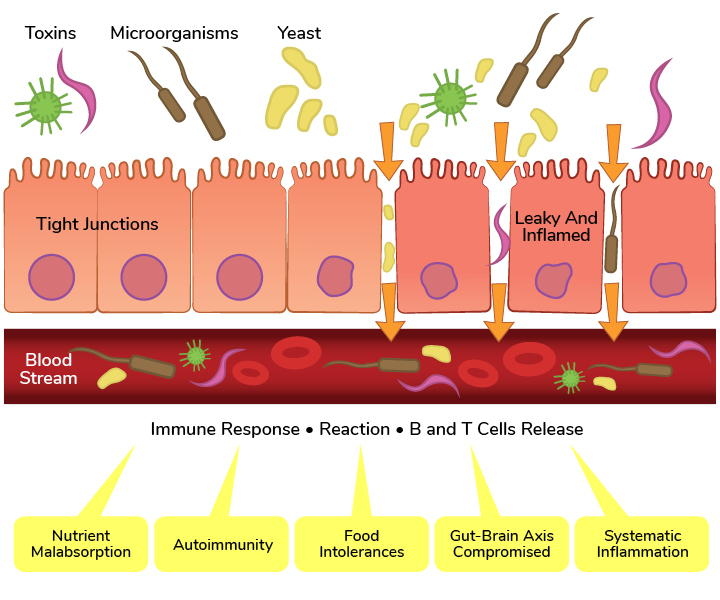
What Happens When Your Dog Has Leaky Gut?
When the microbe is disrupted, the intestinal wall will be affected in three ways:
- The mucous lining shrinks. The mucous membrane protects your dog’s gut lining from abrasions from his meals. When it becomes thin, the cells beneath will be scratched and eventually inflamed. This is a problem because …
- Inflammation of the lining will cause the tight spaces between the cells to open up.
- The intestinal cells either die off or become damaged. And this leaves them no longer able to screen out any harmful substances. This means harmful substances can enter his bloodstream including bacteria, viruses, fungi, undigested food, and allergens to enter the bloodstream.
Once this happens, his immune system goes into overdrive. And you’ll start to see signs of chronic inflammation … as he tries to process these unwanted, potentially harmful substances entering the body.
Every time your dog eats, this cascade of immune hypersensitivity will follow. This repetitive overdrive means the cells in his body will become chronically inflamed.
Then you’ll start to see the symptoms of leaky gut, which include:
- Food allergies and sensitivities- Resulting in itching, scratching, hot spots and skin irritations.
- Yeast infections -Dysbiosis will allow yeast in the microbiome to grow out of control. And leaky gut will allow the yeast to enter the body and cause skin issues like infected ears and yeasty feet.
- Inflammatory bowel disease, diarrhea, constipation
- Autoimmune issues (such as cancer and allergies)
- Joint conditions and pain
- Thyroid disease
- Liver dysfunction
- Pancreatic insufficiency
- Diabetes
- Mood disorders
- Weight gain
- Low energy and slow metabolism
While you may think “my dog has allergies” or “my dog has joint pain.” Have you ever thought your dog just has dysbiosis?
Because I hope you’re starting to see that most dogs do!
The good news is we can repair some of this damage with better nutrition. Here’s how …
5 Ways To Reverse Dysbiosis And Support Your Dog’s Microbiome
Fortunately, you can help restore a healthy balance in your dog’s microbiome … and you can do this mainly with some simple changes in diet. Here are the three main dietary changes you should make:
1. Avoid Pesticides, Drugs, And Toxins (Especially Antibiotics)
Any of these chemicals will damage the delicate ecosystem living in your dog’s gut. So look for natural alternatives whenever possible because drugs and chemicals will damage the microbiome … and cause more illness and disease in the long run.
2. Feed A Raw Diet
Studies show that dogs fed a raw diet have a more diverse microbiome … and when it comes to gut health, diversity is key.
On the other hand, kibble fed dogs have a less diverse microbiome. They also have large populations of bacteria species associated with inflammation and bowel disease.
3. Feed Probiotics
Probiotics are literally healthy (pro) bacteria (biotics). Probiotics help your dog restore his microbiome. And they’re a necessity if your dog ever needs antibiotics or other drugs.
There are two ways to get friendly bacteria into your dog: with probiotic products or with probiotic-rich foods.
Unfortunately, not all probiotic supplements are equal.
Here are some tips for choosing a good quality probiotic:
- You want to look for a product that carries more than just a few strains of bacteria. If you look on the label, you’ll see a good mixture of Lactobacilli and Bifidobacteria. These are the most important strains and you’ll see them displayed as B and L (for example, B. lactis or L. acidophilus).
- Look for probiotics with a minimum of 50 billion CFUs. This is the number of bacteria ‘colony-forming units’. You can find this number displayed on the bottle. And you’ll want to look for a minimum of 50 billion CFUs because few of the bacteria will survive the highly acidic stomach in your dog. So the higher the CFUs, the more likely the product is to help your dog.
- Add soil based probiotics. These include Bacillus subtilis and Bacillus coagulans. Soil based probiotics form a protective coating and are much more likely to survive your dog’s digestive tract and colonize in the digestive tract. Because of this, you will only need 1 to 2 billion CFU of a soil based probiotic.
- Pass on probiotics that are made from dairy or other sources that can create allergy symptoms in your dog.
Dosage: If you buy a product made for dogs, follow the dosing directions on the container. Or if you have a human probiotic supplement, assume the directions are for a 150-pound human and adjust the dose to your dog’s weight.
RELATED: When probiotics help and when they harm …
4. Add Prebiotics
Adding a prebiotic will make your probiotics more effective. Prebiotics are non-digestible food ingredients that feed the probiotics in the gut.
You can buy prebiotic supplements like inulin and fructooligosaccharides (FOS). As with all human supplements, assume the dose is for a 150 lb person and adjust for your dog’s weight.
And there are whole food sources of prebiotics that you can feed. A few good ones for dogs are:
- Fermented foods: give your dog kimchi or sauerkraut as a source of prebiotics and probiotics. Be careful with kefir as many dogs are lactose intolerant.
- Dandelion greens: sprinkle on food 1 teaspoon of dried greens per 20 lbs of body weight per day.
- Garlic: feed 1 teaspoon of chopped raw garlic per 30 lbs of your dog’s weight per day.
- Mushrooms: give 1/8 tsp per 25 lbs body weight per day.
RELATED: 6 Natural Prebiotics For Dogs: Why Probiotics Aren’t Enough!
I know you take great care of your dog or you wouldn’t have made it this far into the article!
And now you know it’s not only important to pick the best foods and care for your dog … you also need to be a caregiver to a few trillion of your dog’s best friends too.

